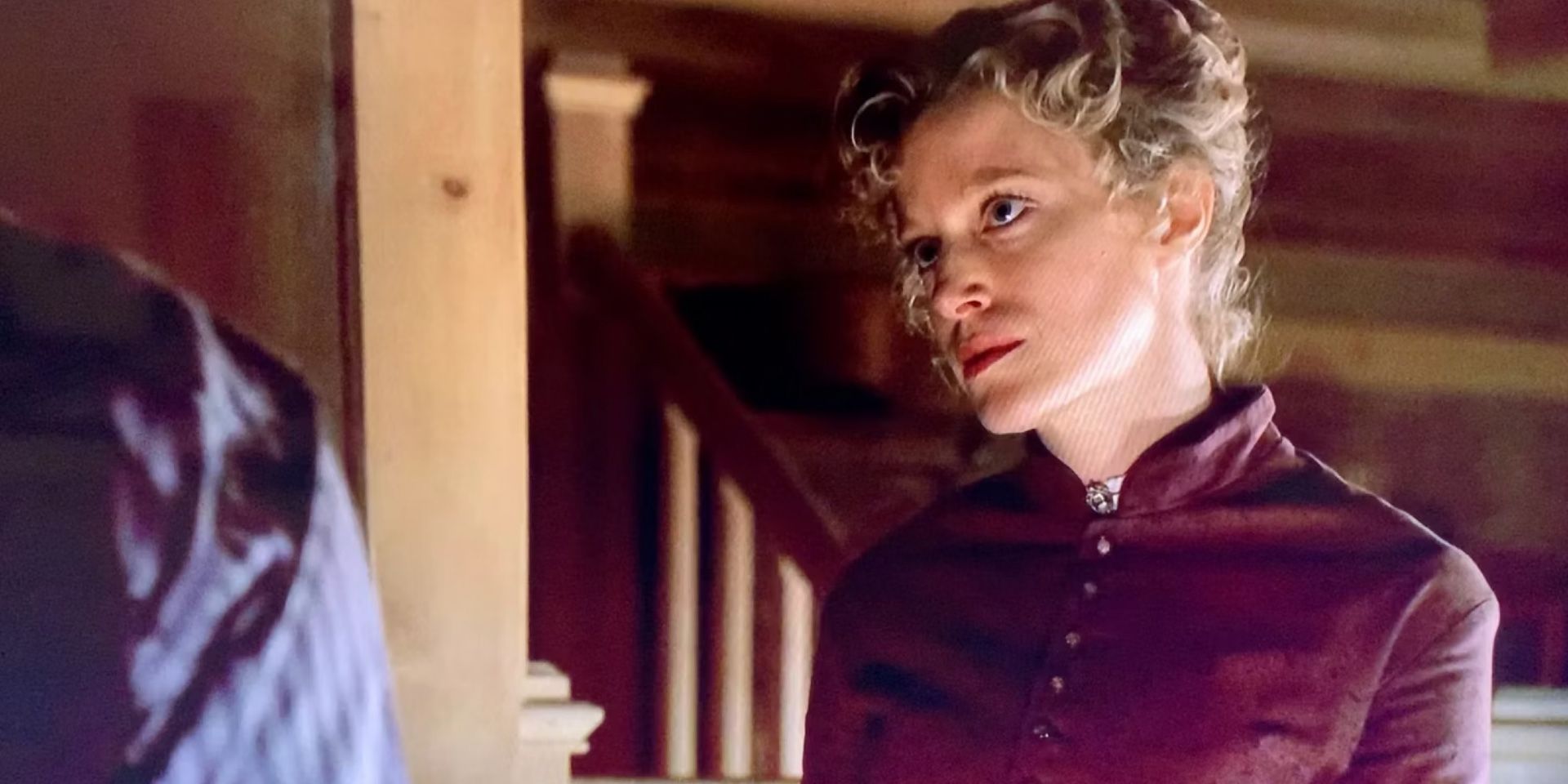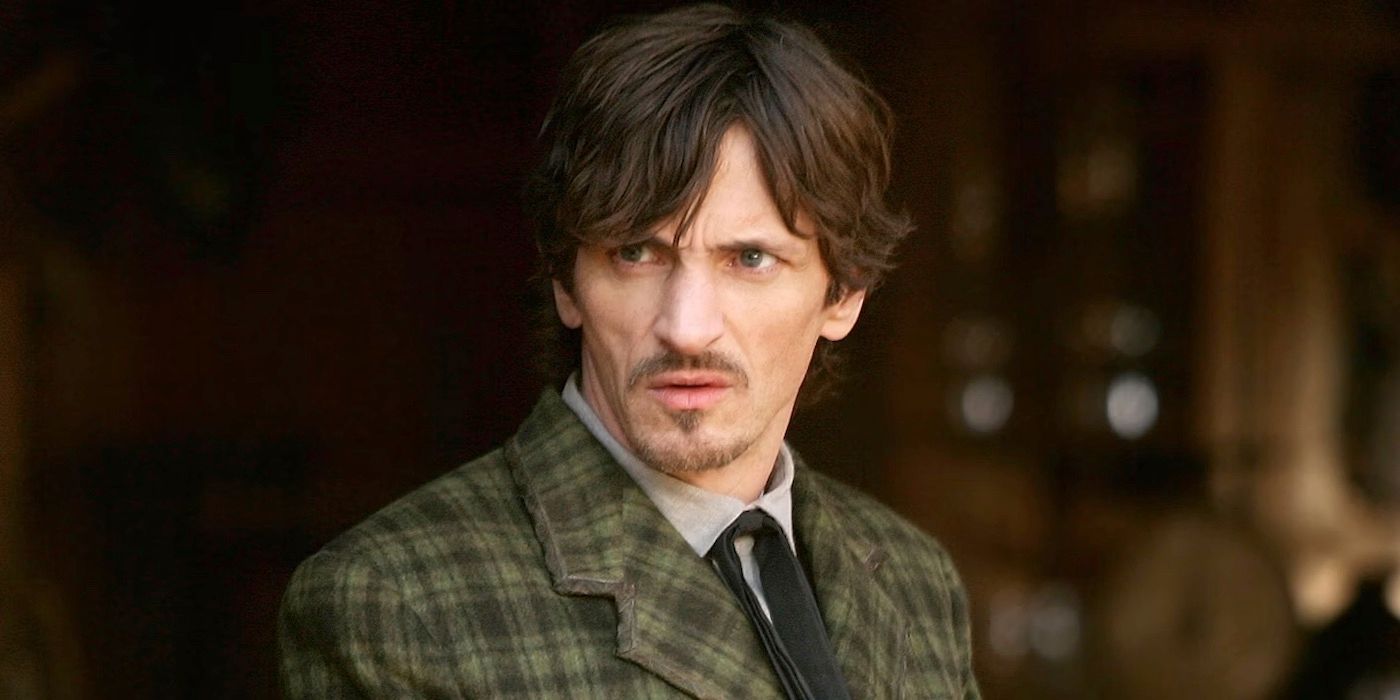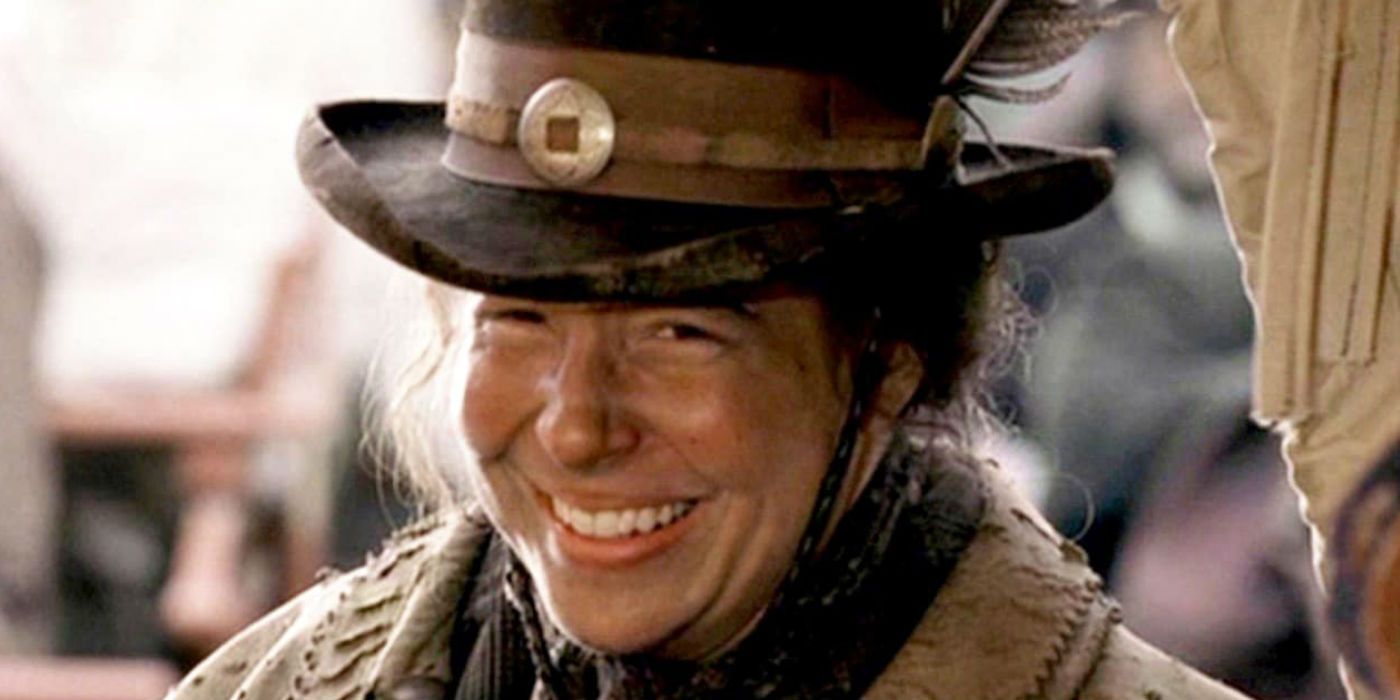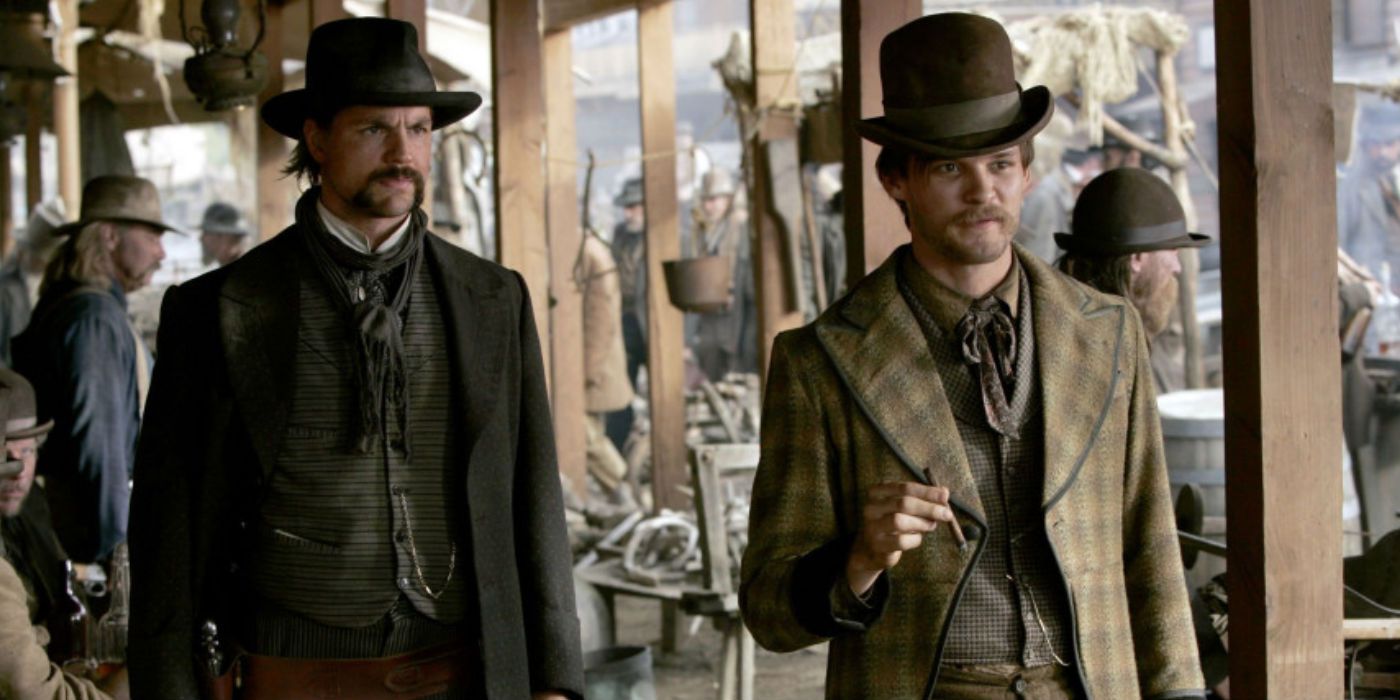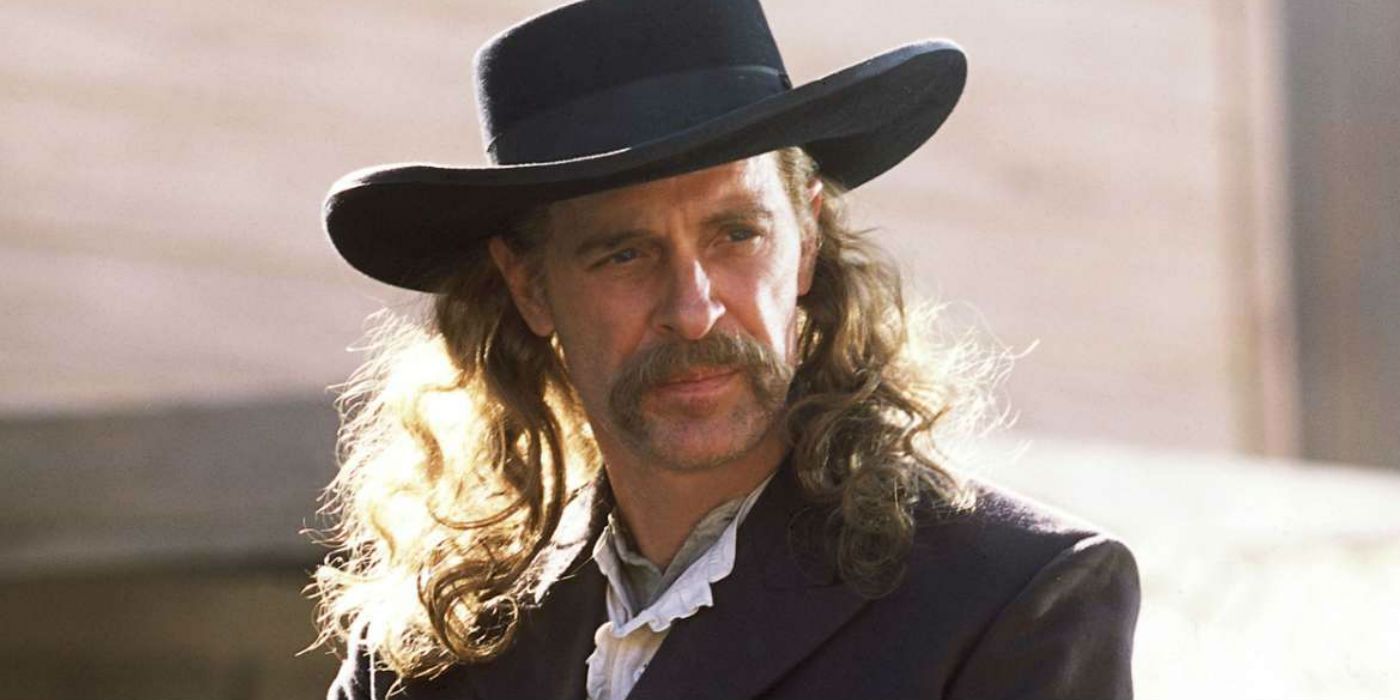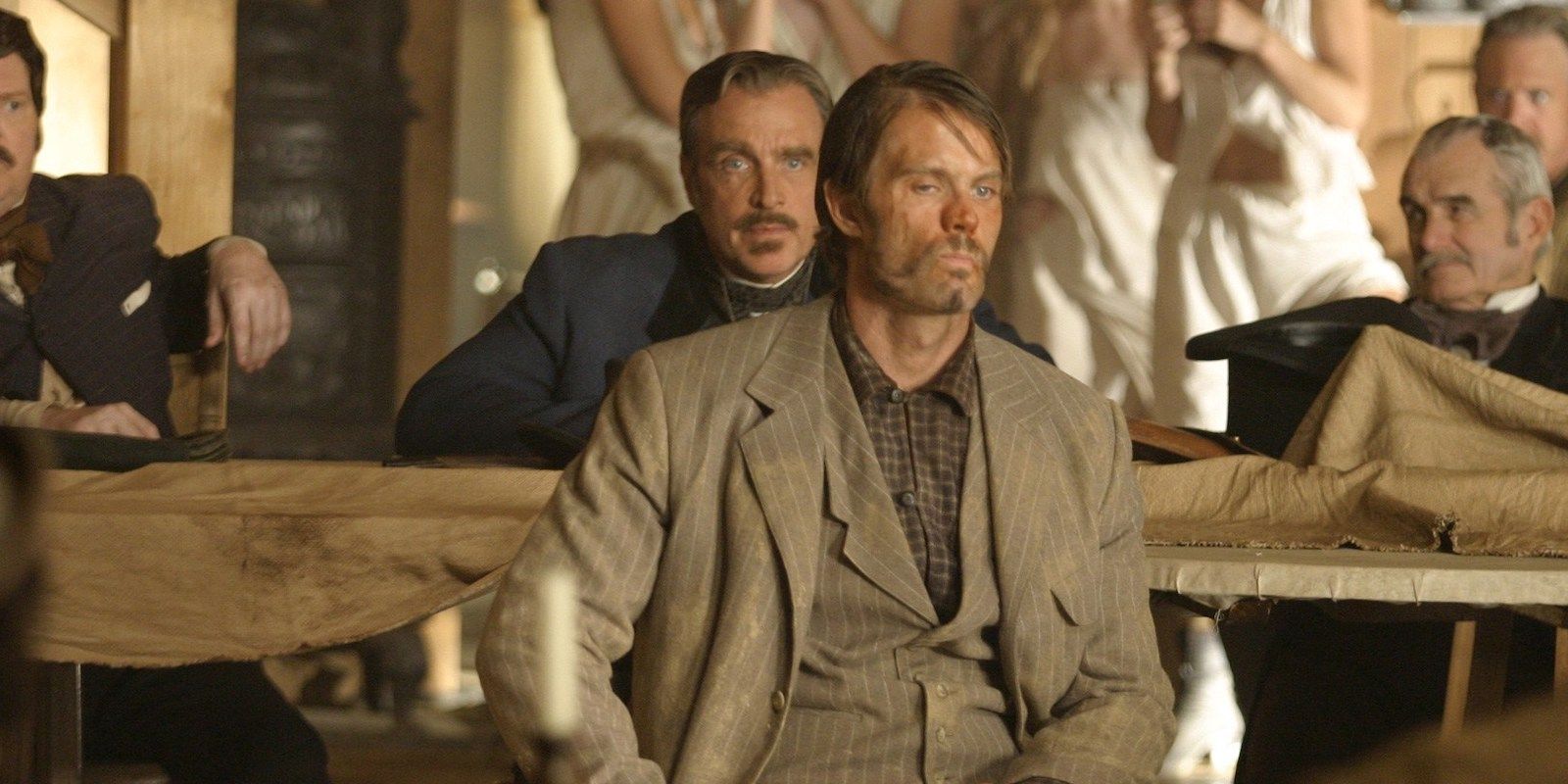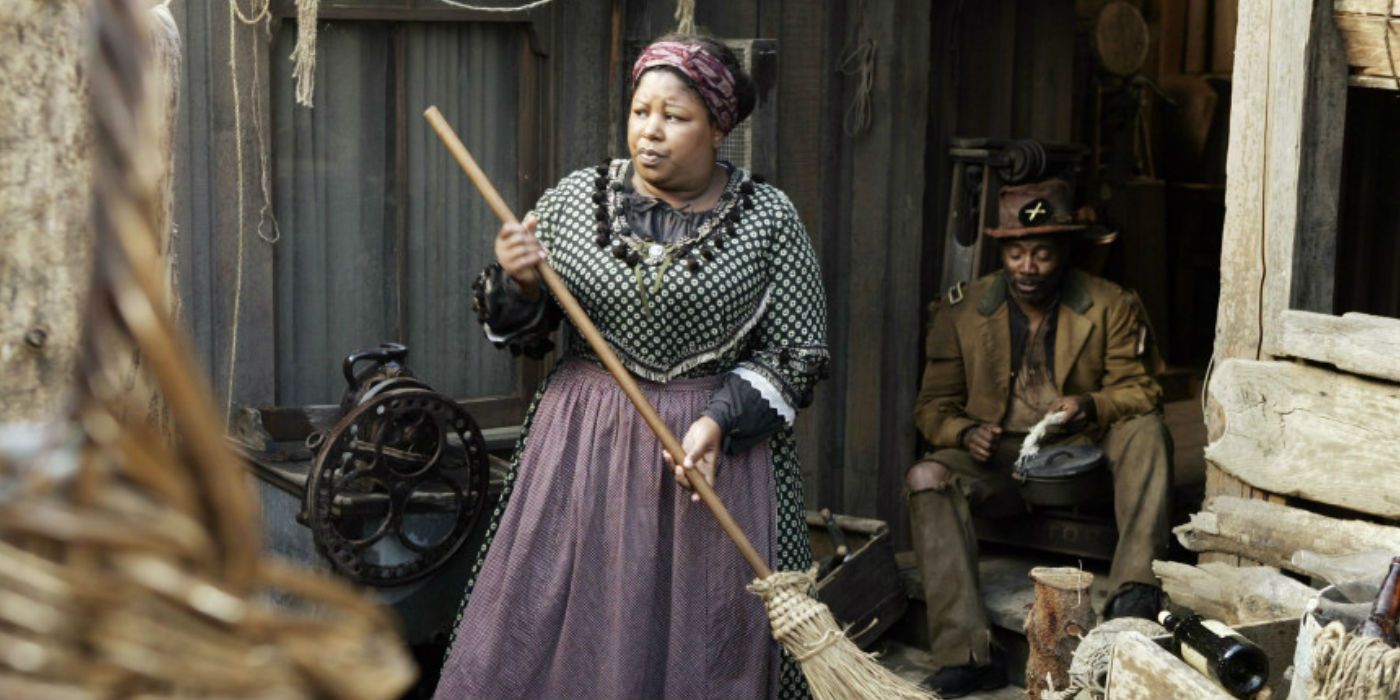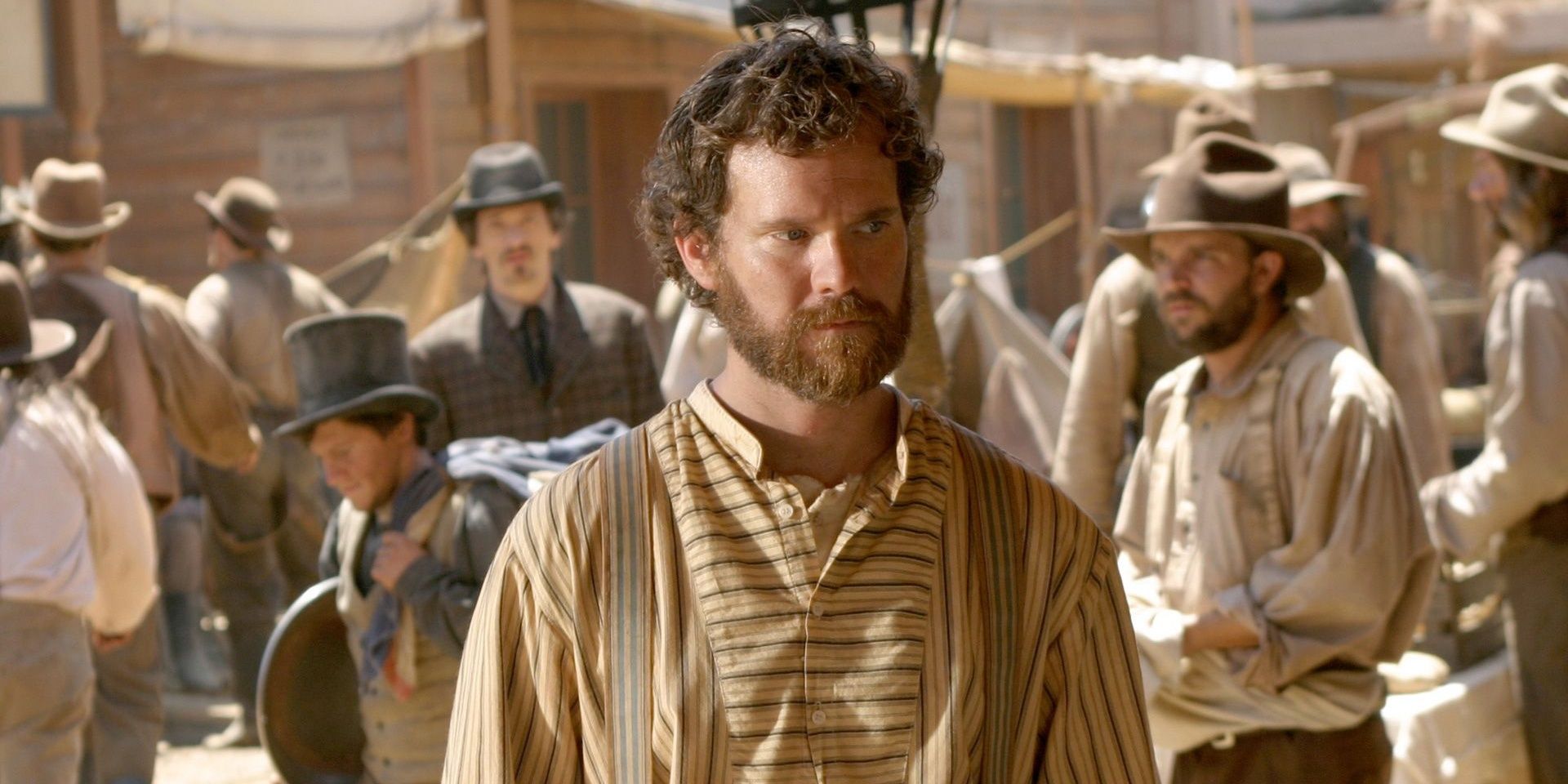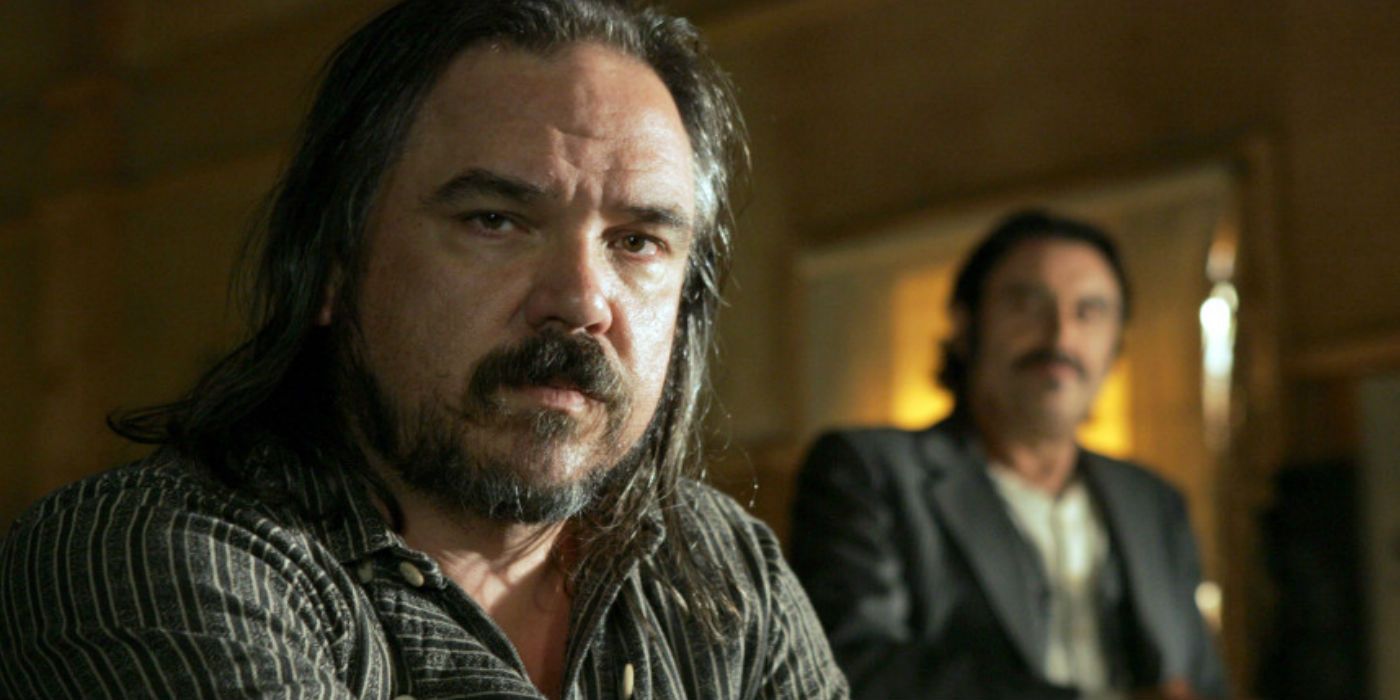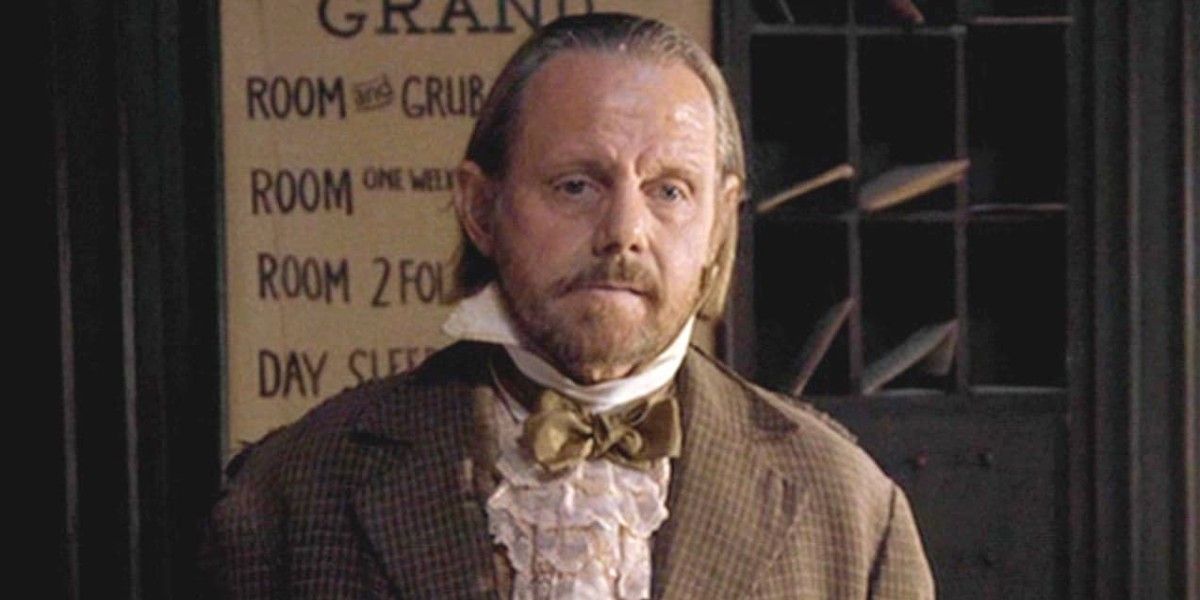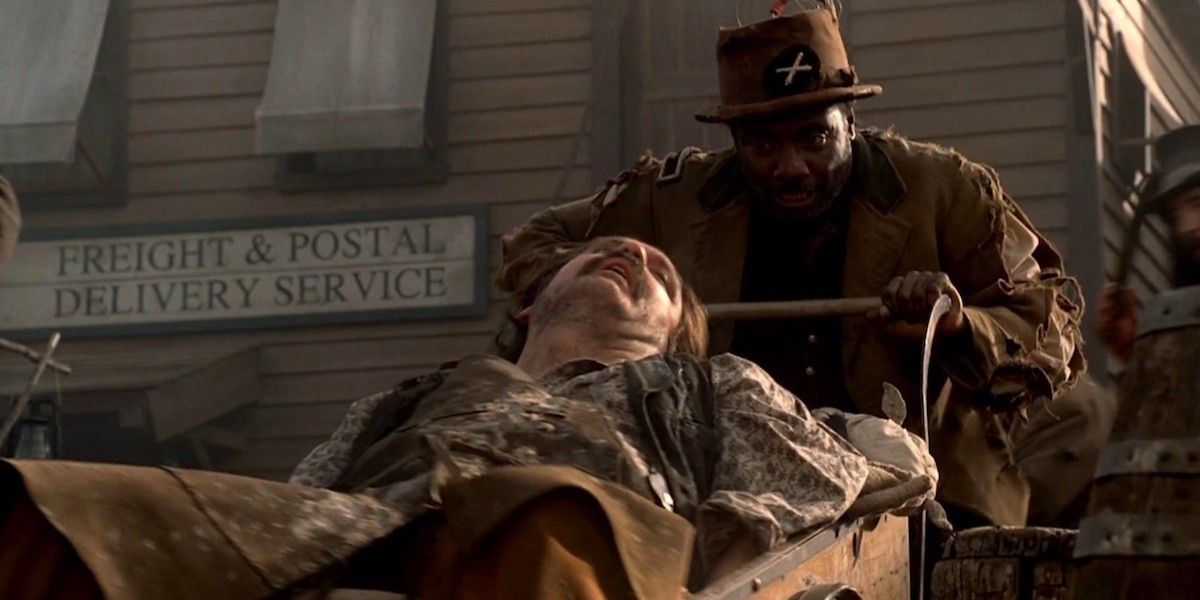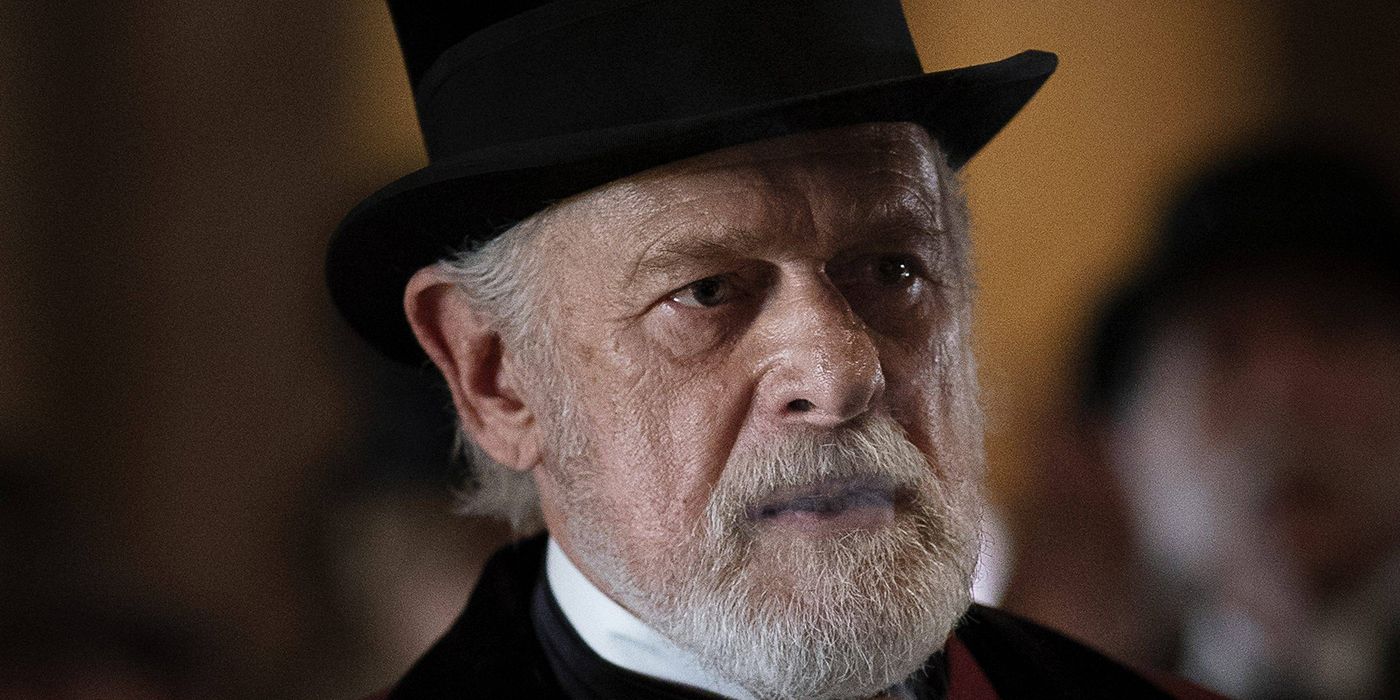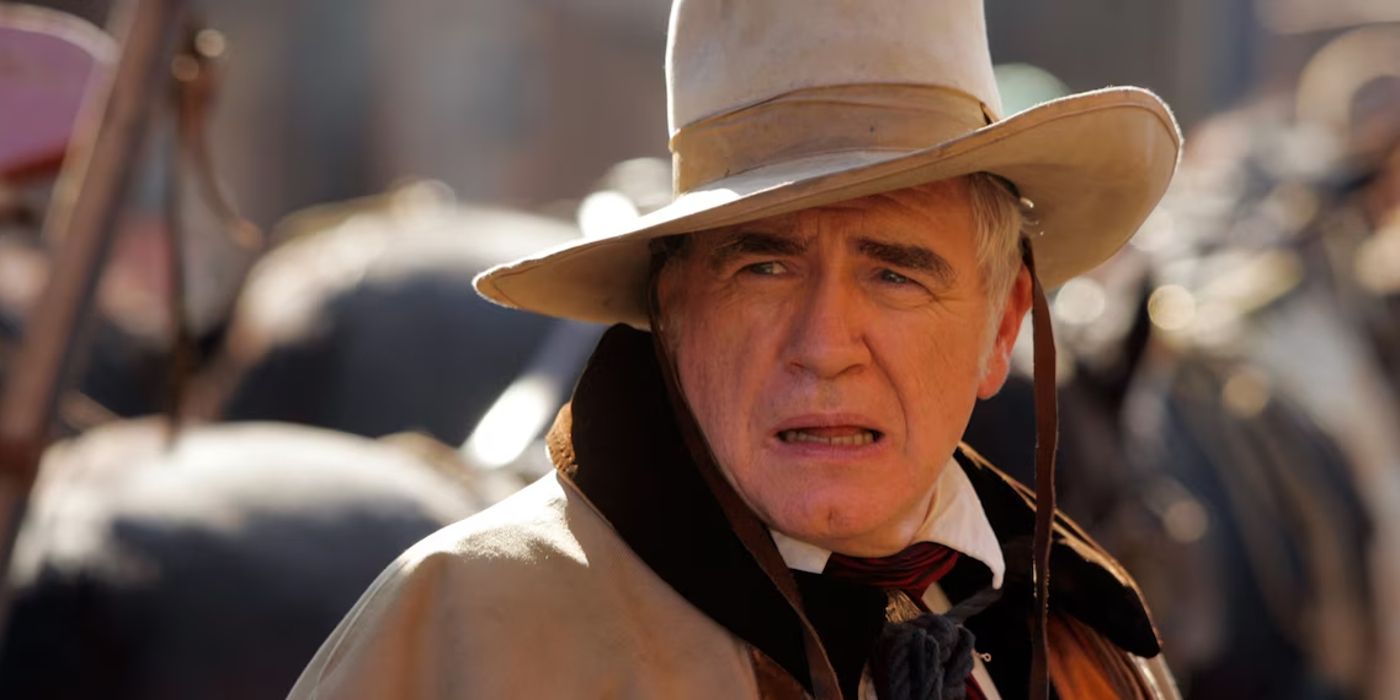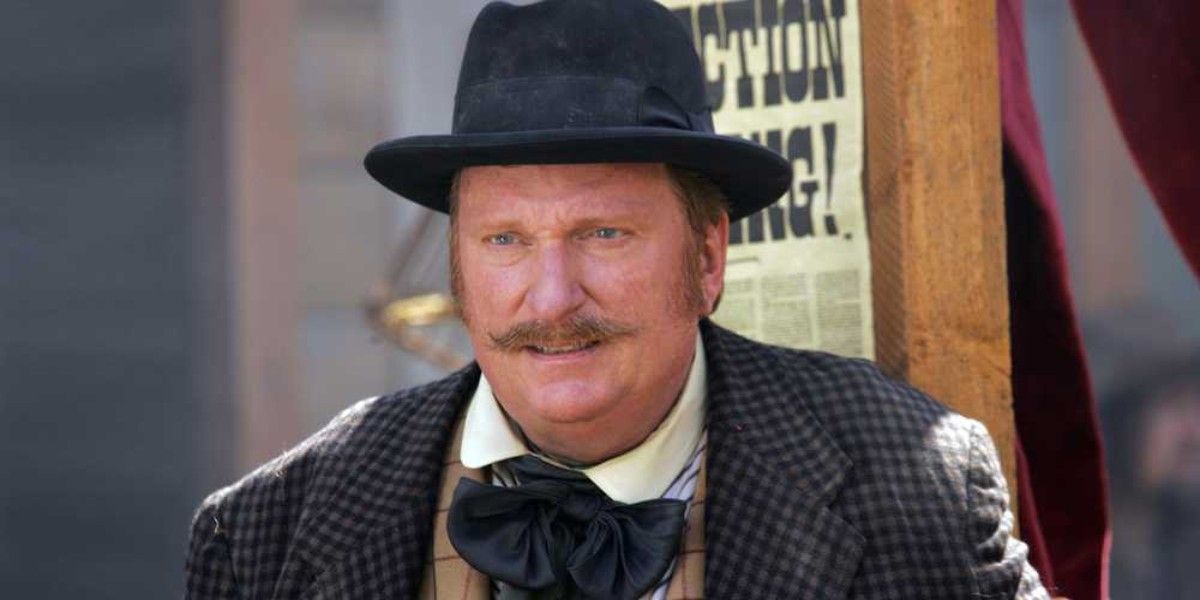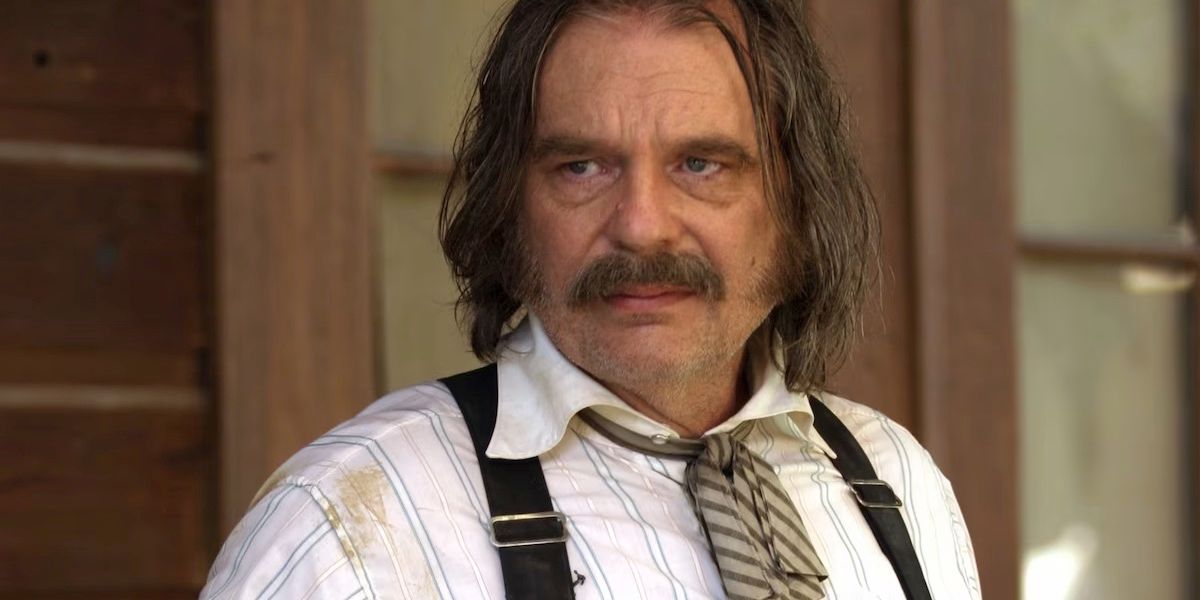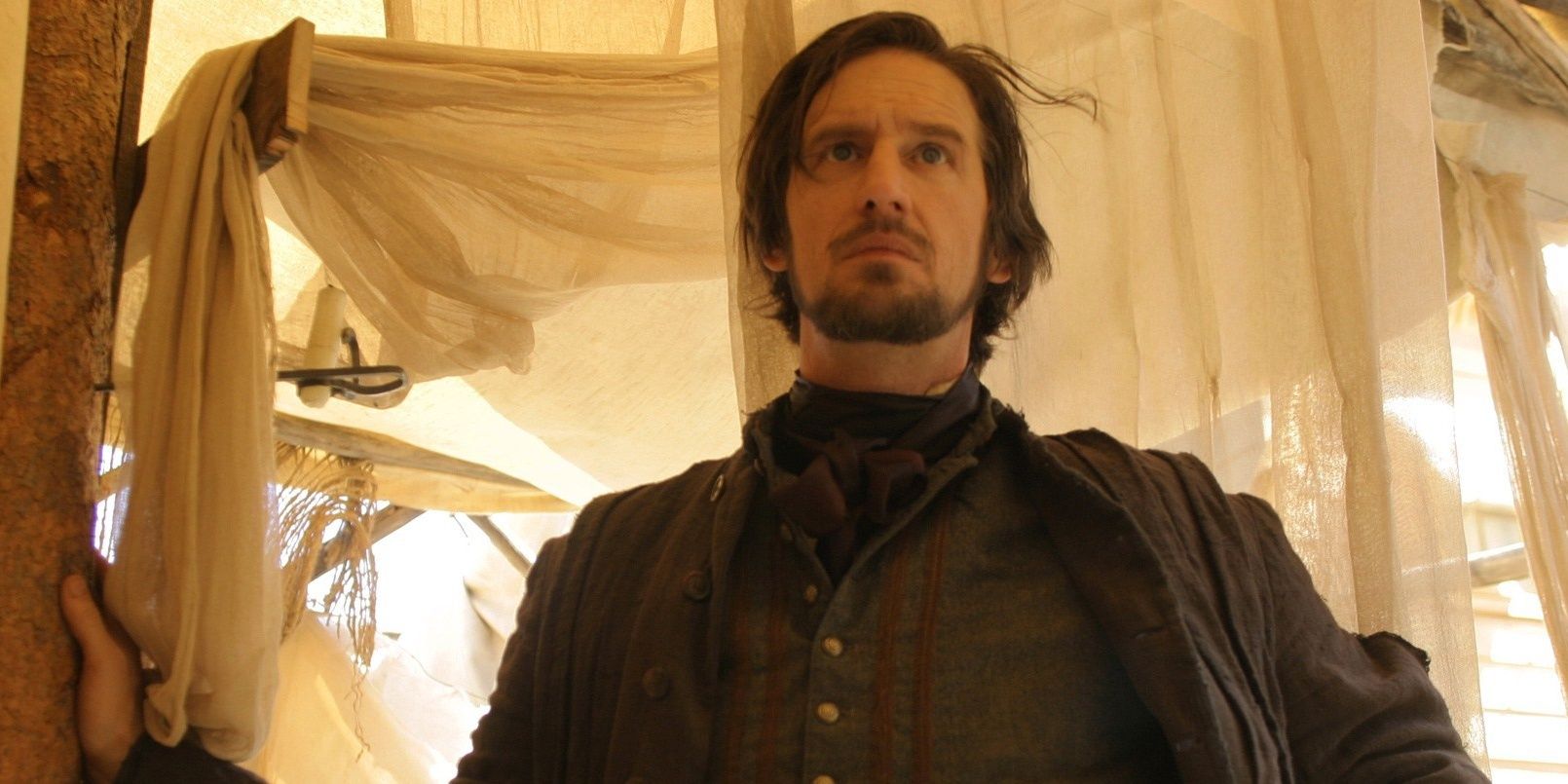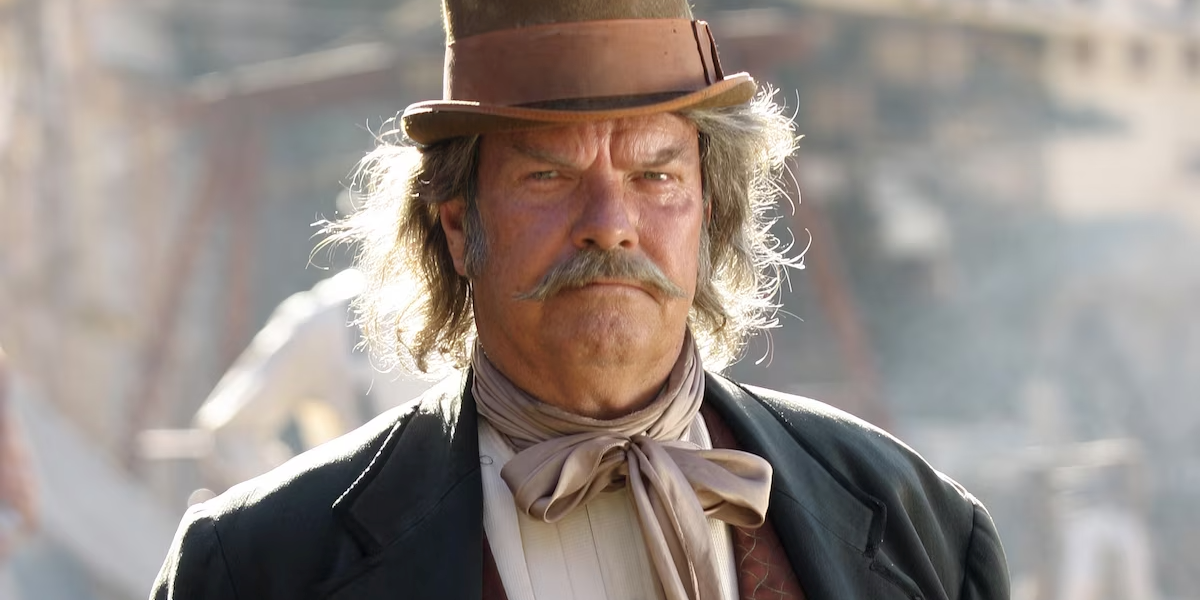Summary
- “Though Deadwood used a mix of real and fictional events, it did a great job capturing the colorful characters who shaped the town.”
- “Al Swearengen, both in the show and in real life, was a ruthless and sadistic figure who committed unspeakable acts of cruelty.”
- “Seth Bullock, unlike Swearengen, was a pillar of the community and played a vital role in bringing law and order to Deadwood.”
Though plenty of characters that dotted the cast roll of Deadwood were entirely fictional creations of the show, there were a surprising number who were based on real-life historical figures. Running for three seasons, Deadwood followed the events of the real frontier town of Deadwood, South Dakota. Over the course of the show, Deadwood grew from little more than a temporary, illegal camp in the Dakota Territory of the Old West to an established town full of notable people.
Deadwood strove to be as accurate as possible regarding the clothing, buildings, and tools of the time, with the production even using diaries of the former townspeople and newspaper articles of the time to recreate the town as it was in the late 1980s. Still, as with virtually all TV shows based on history, Deadwood used a mix of real events, fictional events, and real events that were changed for the purposes of the show. Despite that blend of fiction and fact, one thing Deadwood did well was its people: almost two dozen characters in the series were based on real-life figures who lived in Deadwood.
Is Deadwood Historically Accurate? 10 Events The Show & Movie Got Right
Deadwood is based on several real events that occurred in the mining town, including Wild Bill Hickok’s murder and other Wild West lore.
21 Al Swearengen
Played by: Ian McShane
In both the Deadwood series and the real Deadwood, Al Swearengen was a larger-than-life figure. In the series, Ian McShane’s portrayal is ruthless, underhanded, and often cruel. He has no remorse for his actions and has a streak of sadism that he often employs for his own merciless ends.
Shockingly, the real Al Swearengen was arguably even worse, with the show leaving out some of his well-documented cruelties. Married three times, Swearengen abused his wives with an unnerving brutality. He also lured young women to Deadwood by promising them good jobs in his Gem Theatre, then locked them into indentured servitude or threw them out on the streets. When the Gem Theatre burned down for a third time in 1899. Broke and angry, Swearengen left Deadwood for good and was killed shortly after. Fittingly, it’s not clear whether he was killed while trying to hop a train or if he was murdered.
20 Seth Bullock
Played by: Timothy Olyphant
In contrast to Al Swearengen and his duplicitous dealings in Deadwood, Seth Bullock was a good man and pillar of the community. The real Seth Bullock was born in Canada before emigrating to the United States and settling in Helena, Montana as a young man. While there, he served as a politician and sheriff and helped to create Yellowstone National Park. It was in Montana that he also befriended Sol Star and the two men set up their hardware store. Soon after, Seth and Sol moved their hardware store to Deadwood to chase the opportunities provided by the booming Gold Rush.
At the time, Deadwood was a lawless, violent place and some of the town’s residents were searching for ways to apply some semblance of law to the frontier town. With his background, Seth Bullock was a natural fit as Deadwood’s first sheriff (officially the Lawrence County Sheriff); his position as a lawman brought him into direct conflict with Swearengen many times. Later, Bullock, with the help of Star, would bring alfalfa farming to South Dakota, became a U.S. Marshal, opened the Bullock Hotel, S&B Ranch Company, and the Deadwood Flouring Mill, became a significant investor in the booming mining industry of the region, befriended future President Theodore Roosevelt, and co-founded the town of Belle Fourche. Seth Bullock died in September 1919 from cancer at his Belle Fourche ranch.
19 Martha Bullock
Played by: Anna Gunn
In her own way, Martha Bullock became as respected in Deadwood as her husband, Seth, during their tenure there. Martha and Seth had known each other when young and subsequently married in 1874 in Salt Lake City, Utah. When Seth and Sol Star decided to move to Deadwood, Martha and their daughter, Madge, temporarily went to live with her parents in Michigan while Seth cleaned up the town. Once he’d brought some semblance of order to Deadwood, Martha moved to Deadwood, reuniting the Bullock family.
While Seth worked to bring law and order to Deadwood, Martha worked to bring civilization and culture to the town. She helped found the ladies literary group the Round Table Club and served as its president. The Round Table Club then went on to found the Deadwood Public Library; both the club and the library exist today. Martha was also involved and hands-on with her church, and regularly helped organize community events to bring Deadwood together. She did all of this on top of managing the Bullock household, their three children, and, for a time, their nephew Douglas. Martha Bullock died in 1939; both she and Seth are buried in the Mt. Moriah Cemetery in Deadwood.
18 Solomon “Sol” Star
Played by: John Hawkes
He may not have been the grandiose figure that Seth Bullock was, but Solomon “Sol” Star was as integral to the foundation of Deadwood and the region’s success. Sol Star was born in 1840 in Bavaria, Germany, to a Jewish family but was sent to live with relatives in Ohio when he was 10. As a young man, he moved to Helena, Montana, where he struck up his famous friendship with Seth Bullock while serving as the personal secretary to the governor.
In Deadwood, Sol was the co-founder of everything that he and Seth Bullock accomplished together, including their hardware store, the S&B Ranch Company, the Deadwood Flouring Mill, the Bullock Hotel, and founding the town of Belle Fourche. While Seth Bullock was more of a lawman, Sol Star had a knack for politics. He served on the first Deadwood town council, was the town postmaster, and eventually became its mayor for 14 years. Later, he served in the South Dakota House of Representatives and the Senate before becoming the Clerk of Courts for Lawrence County, a position he held for two decades until his death in 1917. Instead of laying him to rest in Deadwood, his family had his body transported back to Missouri to be buried.

Deadwood: 5 Best Fight Scenes (5 That Let Fans Down)
Violence is par for the course in the lawless town of Deadwood. But while HBO’s Western series had some epic brawls, other fights let fans down.
17 Calamity Jane
Played by: Robin Weigert
Calamity Jane was a towering figure in the frontier era of the American West, leaving a legacy as colorful and large as any of her male counterparts of the time. It’s known that she was born Martha Jane Canary on May 1, 1852 in Princeton, Missouri. Beyond that, much of the information about her early life can’t be confirmed, as many of the details came from Canary herself, and she exaggerated or outright fabricated certain details of her life to promote her career as a sharpshooter. What is certain is that she was known by her nickname of “Calamity Jane” by the time she arrived in Deadwood in 1876 (on the same wagon train as Wild Bill Hickock) as the famous frontierswoman who dressed like a man.
Calamity Jane settled in the Deadwood area and once claimed to have been married to Wild Bill Hickock at the time of his death, though, like many of her claims, it’s in dispute. Even without her exaggerations, Calamity Jane’s life was remarkable. She once saved a stagecoach by chasing off its Native American attackers; when the driver was killed, Calamity Jane jumped into the driver’s seat and drove the stagecoach safely to Deadwood. Another time, when a smallpox epidemic hit Deadwood, Jane was in the thick of it helping to nurse the afflicted. Calamity Jane died of pneumonia and inflamed bowels at the Calloway Hotel near Deadwood on August 1, 1903.
16 Wyatt (& Morgan) Earp
Played by: Gale Harold & Austin Nichols
The Deadwood series depicted the legendary lawman Wyatt Earp (along with his brother, Morgan), arriving in the town. Unlike many historical drama TV shows that fudge timelines to bring together historical figures who never met, Earp really did come to Deadwood for a brief period. His time in Deadwood happened four years before the infamous shootout at the O.K. Corral in Tombstone, Arizona alongside his brothers and Doc Holliday.
In 1976, Wyatt and Morgan were chasing the gold rush like so many others heading to Deadwood. Some accounts say that he was interested in becoming the wild town’s marshal and it caused a clash between him and Seth Bullock, who was by then already the lawman of the town. However, nothing about this could ever be found in the town’s newspapers of the time; like many other stories of the era, it appears to be made up for grandiose effect. Regardless, the Earps’ time in Deadwood was short-lived. Morgan returned to Dodge City, Kansas upon their discovery that all the land around Deadwood was already claimed, and Wyatt returned the following spring.
15 Wild Bill Hickok
Played by: Keith Carradine
Wild Bill Hickock was a towering figure of the American frontier: a respected gunslinger and lawman, as well as a professional gambler – a true archetype of the Old West. Born James Butler Hickock in Troy Grove, Illinois in 1837, he showed a remarkable aptitude for marksmanship and sharpshooting from a young age. Having always been enamored with the frontier, however, Hickock set out west after a fight with another boy in which each thought he’d killed the other.
Hickock moved to Kansas and joined the Jayhawkers antislavery vigilante group and served as a scout in the U.S. Army before joining the Union Army during the Civil War. After the war, he served as deputy U.S. marshal and lawman in various frontier settlements, during which time he was engaged in several shootouts of questionable justification. With his wild card reputation as a gunslinger and master gambler growing, he joined Buffalo Bill Cody’s traveling Wild West Show. Wild Bill met his end in Deadwood in 1876 when he was shot in the head from behind by a drunkard named Jack McCall. Interestingly, it’s rumored he told some of his friends before his death that he felt he’d die in Deadwood.
14 Jack McCall
Played by: Garret Dillahunt
Jack McCall would have lived and died an unremarkable life and never been a footnote in history had it not been for one ill-advised act of revenge. Not much is known about McCall’s life before his murder of Wild Bill Hickock. It’s estimated that he was born in the 1850s in Kentucky, but the exact year isn’t known. He had three sisters, but later left his family to become a buffalo hunter out west. Eventually, he settled in the mining camp outside Deadwood with the alias of “Bill Sutherland.”
Events were set into motion on August 1, 1976 when Jack McCall and Wild Bill Hickock met at Nuttal & Mann’s saloon. McCall was drunk when he dropped in on a game of poker that included Hickock. McCall quickly lost multiple hands and soon was out of money. Hickock offered to buy McCall breakfast to make up for it and wisely advised McCall not to gamble again until he could cover his losses. Hickock meant it with generosity, but McCall was reportedly insulted and returned to the saloon the next day, again drunk, and shot Hickock point-blank in the back of the head. After two separate trials, McCall, age 24, was publicly hanged on March 1, 1877 for his crimes.
13 Charlie Utter
Played by: Dayton Callie
Charles “Charlie” Utter was very much a real resident in Deadwood, but his portrayal in the show by Dayton Callie is quite different from how he was described in real life. In the show, he’s honest and tough, often showing kindness to others; by all accounts, the real-life Charlie Utter was the same. However, in Deadwood, Utter is shown as somewhat sloppy and uncomfortable around people whereas the real Charlie Utter was quite meticulous about his appearance, dressing in custom-tailored suits and taking care to groom himself neatly. In fact, he also took daily baths, an almost unheard-of practice in those days.
One thing that was true in both the show and reality was his friendship with Wild Bill Hickock. His friendship with Hickock went back long before they both arrived in Deadwood, however. Over the years, Utter was a trapper and hunter, a mine owner and gold prospector, an express rider, and involved in transportation. In his travels, he met Hickock and the two became fast friends. When Hickock was killed by Jack McCall, Utter was the one to claim Bill’s body, arrange for his funeral, and lay him to rest with a proper grave marker in Deadwood.
12 Aunt Lou Marchbanks
Played by: Cleo King
In the Deadwood series, Aunt Lou is a beloved figure and she was reportedly just as beloved in reality. Lucretia “Aunt Lou” Marchbanks was born a slave in Putman County, Tennessee, on March 25, 1832. She grew up with her 11 brothers and sisters on the plantation owned by Martin Marchbanks and raised as a cook and housekeeper before traveling with the Marchbanks’ eldest daughter. After the Emancipation Proclamation declared her free, Lucretia continued to travel west, arriving in Deadwood, like so many others, in 1876.
In the show, Aunt Lou serves as George Hearst’s personal cook and then the head cook of the Grand Central Hotel after Hearst purchases it. In reality, she never worked for Hearst, though she indeed become the kitchen manager at the hotel and it was her cooking that drew people to the hotel and earned her the nickname of Aunt Lou. Over time, her reputation and frugality with money enabled her to open her own business, called the Rustic Hotel, in the Black Hills, and her legendary food ensured the hotel’s success. Aunt Lou sold the Rustic Hotel in 1885 and moved to Wyoming, where she bought a ranch and worked with horses and cattle until her death in 1911.
11 Johnny Burns
Played by: Sean Bridgers
In the Deadwood show, Sean Bridgers’ Johnny Burns is a lackey of sorts for Al Swearengen, working at Swearengen’s Gem Saloon as a bartender and Swearengen’s enforcer. Thanks to his sometimes dimwitted nature, Swearengen both verbally and physically lashes out at Burns. Burns shows more of a moral compass than his boss, sometimes refusing to pull the trigger when Swearengen orders a hit and also showing remorse and regret for his more violent actions.
The real Johnny Burns was much less sympathetic than his TV counterpart, however. Burns really did work at the Gem Theatre, but, while he likely did tend bar, his main role was as a “box herder,” or the one in charge of wrangling the girls who were forced into indentured servitude by Swearengen. Unlike Deadwood’s Johnny, who once refused to kill one of Swearengen’s prostitutes, the real Burns was reportedly brutal toward the girls, often beating them mercilessly and doling out severe punishments when they stepped out of line.
10 Dan Dority
Played by: W. Earl Brown
In Deadwood, W. Earl Brown’s Dan Dority is considerably fictionalized by necessity due to not much being known about him. Even his surname, Dority, is spelled differently than the real Dan, who spelled his last name as “Doherty.” Few details are known about his early life, other than that he was born in Maine in or around 1952 as Dan Michael Doherty. In the 1860 census, he was still living in Maine with his parents and two siblings but the 1880 census listed him as living in Deadwood. It can be surmised that, like so many others, he came to town in 1876.
In the show, Dan Dority is Al Swearengen’s right-hand man, though not quite as merciless as his boss. He held much the same role in real life, managing the Gem Theatre upon its opening in 1877, attending to the respectable business in the front as well as the backrooms that held the prostitutes. Like Johnny Burns, the real Doherty doesn’t appear to have been as sometimes soft-hearted as the version in the show; he often brutalized the girls who worked as prostitutes at the brothel and had no problems with customers doing the same, even when it sometimes lead to the death of one of the working girls.
9 E.B. Farnum
Played by: William Sanderson
In the town of Deadwood, E.B. Farnum was one of the few settlers of Deadwood who didn’t arrive at the town to participate in the gold mining boom. Instead, he saw the potential to cater to that growing group and moved his wife and three children from Wisconsin to Deadwood. He opened up a general store in 1876 and quickly bought up a number of other lots on Main Street, though he was not the owner of the Grand Central Hotel as depicted in the show.
In Deadwood, Farnum is portrayed as foppish and buffoonish, a self-important man who is entirely controlled by Al Swearengen but harbors delusions he is his own man. By contrast, the real Farnum appeared to be a thoughtful and prudent leader as the first mayor of the town. During his time as mayor, he convinced the Army to establish a post near the town, established a quarantine house during Deadwood’s smallpox epidemic, set up Deadwood’s first fire department, the first telegraph center, the first school, and a system of street cleaning while also being the Justice of the Peace, judge, and head of the school board. It’s not known exactly when he left Deadwood, but he was listed as living in Tennessee in the 1900 census.
8 Samuel Fields
Played by: Franklyn Ajaye
Samuel Fields, played by Franklyn Ajaye, was one of Deadwood‘s most flamboyant figures. Almost impossibly, the real Samuel Fields might have been an even more colorful character. In the series, he first befriends Calamity Jane. In reality, it’s not entirely clear how he arrived in Deadwood, though most records estimate that, like most who moved to the area to seek their fortune, Fields arrived in 1876.
Fields immediately established his showman-like, larger-than-life persona upon arriving in Deadwood when he told everyone he’d been a general in the Union Army during the Civil War, a claim that was entirely untrue. As one of Deadwood’s few African-American residents, Fields was an outspoken participant at “Colored Citizens Meetings” and soon earned a reputation as an eloquent and entertaining speaker. He was regularly quoted in the local papers, earning himself a growing list of nicknames around town. Fields seemingly always found himself at the center of mischief in Deadwood, whether through sheer accident or by association. Not much is known about Fields’ exploits after 1890, but his time in Deadwood provided enough material for a lifetime.
7 George Hearst
Played by: Gerald McRaney
Unlike others in the series who sought out Deadwood to seek their fortune, George Hearst was already a wealthy mining tycoon by the time he came to town. He’d already established mining camps in Utah, Nevada, California, and Montana, and had interests and investments in mines and significant lodes all around the country. He was a ruthless businessman, but respected, largely considered the most significant prospector and expert in mining property potential in the West. He also acquired the San Francisco Examiner as payment for a gambling debt; years later, his son William Randolph Hearst took control of the newspaper and turned it into the cornerstone of the Hearst media empire.
In the Deadwood series and movie sequel, Hearst sends his employee Francis Wolcott to acquire stakes in the gold claims of Deadwood. Employing less than scrupulous means, Hearst is depicted as a clear villain in the show. In reality, while he did indeed visit Deadwood in his lifetime, Hearst’s attempts to acquire the Homestake Mine weren’t as ruthless or diabolical as portrayed in the series. He was a respected figure and noted philanthropist; while several characters in Deadwood differed vastly from their real-life counterparts, George Hearst’s character was arguably done the dirtiest.
6 Jack Langrishe
Played by: Brian Cox
Jack Langrishe was one of Deadwood’s more colorful figures, just as he was in the Deadwood series. Born in Dublin, Ireland, as John Sewell Folds Jr., he moved to the United States when he was about 20 years old. He adopted his stage name of Langrishe after moving to New York City, becoming a full-time stage actor, magician, and comedian. Unlike the series, there was no solid evidence to suggest that Langrishe was gay: in 1849, he met and married actress Jeannette Allen in Pittsburgh, Pennsylvania, and the pair formed the Langrishe and Company traveling theater troupe.
Langrishe and Jeanette were an integral part of creating a vibrant cultural scene for the residents of Deadwood upon their arrival in 1876, with them soon setting up shop and leasing the existing theater for their company. Langrishe’s troupe provided a source of entertainment for Deadwood, with burlesque, minstrels, dancers, acrobats, singers, and all forms of entertainer gracing the stage. After Jack Langrishe bought and remodeled his own theater, renamed the Langrishe Theater, it also served various non-entertainment functions for the town, from the trial of Jack McCall, to the first wedding performed in Deadwood, to a meeting place for various organizations. Jack Langrishe died in Wardner, Idaho, on December 12, 1895 after a brief illness.
5 A.W. Merrick
Played by: Jeffrey Jones
Albert Walter “A.W.” Merrick was Deadwood‘s proprietor and publisher of the local newspaper, the Black Hills Pioneer. The series portrays him as an upright and morally-straight character, committed to telling the truth about unfolding events while navigating his friendships with the prominent citizens of the town. Unfortunately, not much is known about the actual Merrick, particularly his early years.
What is known is that he was born in either 1839 or 1840 in New York City. He later served in the Civil War, rising to the rank of sergeant. After that, he disappeared from the public record until reappearing in the Nebraska Territory, where he was listed as the publisher of the Cuming City Star as well as the Nebraska Enquirer, which was located in DeSoto. By May of 1876, Merrick had landed in Deadwood and launched the Black Hills Pioneer alongside W.A. Laughlin. The official first paper was published on June 8, 1876 and the Pioneer is still published today, the oldest newspaper in the Black Hills region.
4 Tom Nuttall
Played by: Leon Rippy
Like a few other characters in the series, Tom Nuttall was based on a real person, but his name was changed for the purposes of the show. In reality, the proprietor of Nuttall & Mann’s Saloon No. 10 was named William “Billy” Nutall, not Tom. In the series, he’s already disillusioned with Deadwood and its lawless ways, even before Al Swearengen flexes his iron grip around the town. However, as Deadwood: The Movie showed, he’s still in Deadwood running the No. 10 Saloon a decade later.
The real Billy Nuttall didn’t set down roots as deep in Deadwood as the Tom Nuttall of the show, however. After managing the saloon and the Bella Union Theater for a few years, Nuttall picked up stakes and moved to Leadville, Colorado in 1879 with other Black Hillers moving to follow the gold. There, he opened up his own Bella Union in the summer of 1879, even hiring many of the actors he’d used in the Deadwood theater. His luck soon turned in Leadville, however: his wife left him in 1880, and by 1882, he was jailed in New Mexico for a gambling violation.
3 Reverend Smith
Played by: Ray McKinnon
Reverend Henry Weston Smith was, just as Deadwood depicts him, a compassionate and god-fearing man of the cloth. He also did indeed serve in the Civil War in real life, though he was a doctor and not a field nurse as he was in the show. However, that’s where the commonalities between Ray McKinnon’s depiction of Reverend Smith in Deadwood and the real Smith end.
In the show, Rev. Smith leaves his wife and children to move to Deadwood and become the town preacher after believing he’d received a sign from God. In reality, he was already Methodist preacher before moving to Deadwood. Unlike the show’s storyline of him abandoning his family, Smith’s first wife and infant son died in 1849. He was once again married in 1859 to Lydia Ann Joslin and the couple had four kids. They moved to Deadwood in 1876, where Smith became the first preacher in the Black Hills region. In another change from the show, Smith never had a proper church, but preached on the streets and worked odd jobs to supplement his income. He was killed, along with three other men, on the road to Deadwood in a suspected raid by the local Native Americans.
2 Con Stapleton
Played by: Peter Jason
Con Stapleton, similarly to George Hearst, was another Deadwood character who was somewhat shortchanged in his fictional depiction. In the series, Stapleton only gained his short-lived position as the marshal of Deadwood thanks to a campaign of begging Al Swearengen to appoint him. Otherwise, he was a dim bulb card-dealer at Tom Nuttall’s No. 10 Saloon. In reality, Stapleton was elected by the town’s miners in 1876 to be the second marshal of Deadwood, replacing first marshal Isaac Brown after he was killed in the same ambush that also took Reverend Smith’s life.
The rest of the events of the Deadwood series, such as Stapleton being used as a puppet to stir up anti-Chinese sentiment, appear to be entirely fabricated for the show. The real Con Stapleton served as Deadwood’s marshal for over a year and also organized wrestling matches at the Gem Theatre in his spare time. The end of his time as marshal was far less dramatic than depicted in the series. Bullock never stripped him of his badge after Stapleton murdered a Chinese immigrant. Instead, many of Stapleton’s duties naturally transferred to Bullock after he became the sheriff of Lawrence County. Like others, he moved to Colorado with the gold rush. He died in Denver, Colorado in 1879 at just 31 years of age.
Source link

